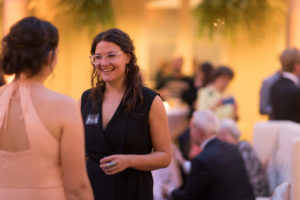THE LEAFLET

So Long to Cristina and Arielle, Our Resident Data Crunchers
Although it would seem that an Urban Forestry Research Associate and Data Assistant would not have similar jobs, you’d be surprised. Arielle Conti, our Urban Forestry Research Associate (left), and Cristina Lewandowski (right), our Data Assistant, helped us make sense of the enormous amounts of tree data we have. They’re off to bigger things, but before they go, we had to ask them a few questions.
You’ve probably seen Arielle Conti, a member of our Technical Services & Research Department at an inventory or during Trees 201. But do you know what album she would bring on a desert island?
Casey Trees (CT): What has surprised you most working at Casey Trees?
Arielle Conti (AC): The incredible community support we have. I can’t tell you how many people LOVE Casey Trees. This organization is held in such high regard among residents, organizational partners and throughout the urban forestry world.

CT: Where (or what) will you be moving on to?
AC: I’ll be joining the team at Rock Creek Conservancy to manage their youth conservation corps. I’m looking forward to taking the skills I learned at Casey Trees and applying them to my new position.
CT: What has been your biggest, best, or favorite achievement during your time at Casey Trees?
AC: Building a program that authentically engages volunteers in citizen science. In the past three years we have inventoried 86 parks, involved over 500 volunteers and measured more than 15,000 trees. This seed was planted in 2015 with three brave volunteers, paper maps and a vague idea of what the program could become. Through an enormously collaborative effort, our inventories are now thriving, with volunteer waiting lists and a beautiful online app to collect the data we need.
CT: Do you have any advice for future research associates?
AC: Mix two parts optimism, two parts positivity and one part realism. Oh and don’t sweat the small stuff.
CT: If you could only bring one album to listen to on a desert island, what would it be?
AC: Fleetwood Mac’s Mirage. I could listen to Gypsy over and over and over again.
CT: Last but not least, favorite tree?
AC: Because I’m feeling nostalgic, Blackgum (Nyssa sylvatica). Early on at Casey Trees, I had the opportunity to walk through a restoration planting at Ft. Dupont with one of Casey Trees’ arborists, Marty Frye. The first tree he helped me identify was a black gum. Since then I’ve passed the black gum in our rain garden almost every day for the past three years. When I started it was barely taller than the doorway. Now the main leader extends halfway up the second floor.
Cristina, our Data Assistant, is a critical part of our Education team, making sure volunteer events are set up properly and that everyone is registered, notified, and set up in our system. She’s moving on from protecting trees to protecting something else. Just what is that? Let’s find out!
Casey Trees (CT): What has surprised you most working at Casey Trees?
Cristina Lewandowski (CL): When I started working here, I was not aware of the multitude of ways in which Casey Trees allows one’s interests and skills to develop. Becoming a Tree Planting Team Leader, for instance, is a great opportunity to not only restore Washington D.C.’s tree canopy, but to also enhance your leadership and communication skills in a friendly, collaborative environment!
 CT: Where (or what) will you be moving on to?
CT: Where (or what) will you be moving on to?
CL: I will join the Strategic Business Operations team at the National Wildlife Federation, America’s oldest and largest conservation organization. The National Wildlife Federation works across the country to unite Americans from all walks of life in giving wildlife a voice.
CT: What has been your biggest, best, or favorite achievement during your time at Casey Trees?
CL: Collaborating with colleagues in all departments to unify our campaign and event workflow protocol, under the guidance of the most amazing Salesforce admin ever, Vince Drader!
CT: Do you have any advice for future data folks?
CL: I will defer to advice offered by Steve MacLaughlin, author of “Data Driven Nonprofits”: be curious; maintain healthy data habits; embrace the use of information to accelerate change; and last but not least, be a good storyteller!
CT: You’re a new addition to the crayon box, what color would you be?
CL: Non-photo blue! This is a shade of blue that is not picked up by copy machines, which allows ideas to be sketched without having to worry about erasing those lines before copying or printing the work.
CT: Last but not least, favorite tree?
CL: Oaks (Quercus spp.) have always been my favorites. The Quercus species supports the largest number of butterfly and moth species (534) of all plant species in the U.S. mid-Atlantic region.